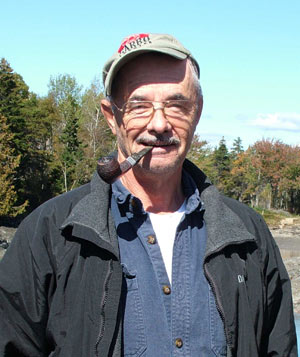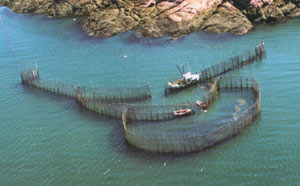
Dana Rice, NEFMC member, at his wharf in Birch Harbor. After decades
of being in the lobster business and running the herring carrier Jacob Pike, Rice has a long range view of the industry. Active in the management process he has long advocated for trawler bans in area 1. At the same time he is aware of the long term need for lobster bait. Photo: Fishermen's Voice |
Council member Dave Preble, in light of a retroactive risk assessment. called for a 45,000 MT TAC. This figure was brought up to 50,000 before the issue went to the floor.
In order to consolidate political power, fishermen have formed coalitions in recent years. One of these coalitions is CHOIR (Coalition for the Atlantic Herring Fishery’s Orderly, Informed and Responsible Long Term Development). CHOIR represents many tuna and hook fishermen and has support from a wide range of interest groups in and outside the fishing industry. They are based in North Chatham, MA, on Cape Cod.
Another coalition is the Northeast Seafood Coalition based in Gloucester, MA, and represents many ground fishermen, among others.
The herring TAC was the central issue at the NEFMC meeting. This TAC could be in place for three years, unless enough acceptable science could show a reason to change it.
By asking other coalitions to sign a letter that they drafted, CHOIR gathered the support of a larger group in order to present a stronger case for immediate and effective action by the NEFMC. CHOIR demonstrated that they were not alone in calling to change what some saw as a potentially disastrous collapse of some fish stocks in the Gulf of Maine.
While CHOIR was the most vocal and active proponent for the reduction in the herring TAC, owners of the mid-water trawlers opposed all proposed TAC reductions.. Two supporters of the 60,000MT TAC were Cape Seafoods from Gloucester, MA; and the Northeast Pelagic Association, representing mid-water trawler companies. Currently, the mid-water boats bring in a large percentage of the herring caught in the Gulf of Maine. Opponents of mid-water trawling say that the boats are too efficient. Critics say, are a cause of the reduced availability of herring. Both fishermen and the scientific community report reduced herring stocks.
Mid-water trawlers have replaced the purse seine boats in the herring fishery. Before the purse seiner, the herring was caught when they poured inshore and were trapped in stop seine nets along shore. Before the use of stop seine, 1930’s, there were weirs all along the coast. These structures were made of thin poles driven into the mud with nets hung on them. This system traced its roots to the earliest settlements on the coast. This method was much less efficient and caught only the fish that wee schooling.
The council heard opinions and emotional debate on all sides of the TAC issue, from those in favor to steep cuts to those who supported no cuts at all. The other changes to herring management, that were not a part of this meeting, are the June 1, 2007 to September 30, 2007 Area 1 (Inshore) mid-water trawler ban and the reduction from 20% allowance for herring spawn in a tow to zero tolerance for herring spawn in a tow.
NEFMC council member, Dana Rice thought a 54,000 metric ton TAC would have been a safer intermediate number. He feared cutting too much too soon. He said he would have supported 50,000 TAC if it did not threaten lobster bait supplies. While he is concerned about the condition of the herring stocks, and said he has , for a long time been an advocate of the mid-water trawler ban”, he is also concerned about the availability of lobster bait this fall and winter.
“My fear is that the 60,000 MT TAC in area 1A will be met in the next couple of weeks and that a shortage of bait will be the outcome,” Rice said. He is the only council member who represents the lobstermen of Maine. Many of the members are from south of Kittery.

Herring weir, Bliss Island, Charlotte County, Canada. Weirs, common along the coast of Maine a few decades ago, caught one kind of fish when they poured inshore. Herring and menhaden, in recent decades, have stopped coming inshore. They were hand hauled into small boats, then loaded into larger boats. It was a fishery that lasted a long time and disappeared very quickly. Photo: Rick Doucet |
A serious bait shortage could be “a potentially drastic social and economic blow to the only healthy fishery in New England,” Rice said. At the same time he said,”The trawler ban will have a positive impact in the long term.
A longtime advocate for the Gulf of Maine herring fishery, Rice has operated a herring carrier for years. His perspective is formed from many decades in the lobster and herring fisheries. In his early days as a fisherman, Rice said that older an fisherman recalled steaming three days across the Gulf of Maine, plowing through waters thick with herring.
He compared this to the $7 million dollar trawler that now goes out for 10 days, making very long tows, and returns with a paltry catch. Rice is looking at this reality against the knowledge, as a lobster dealer, of how much bait lobstermen need to fish a season. “Area 1A is the source of most bait for Maine,” he said. The other areas, 3 and 1B, provide very little herring.
The decision to bring the TAC down to 45,000 MT was questioned by Rice. In response the TAC was moved to 50,000MT, and settled there. Rice later said that, in light of the recent restrictions on mid-water trawlers, the 60,000MT TAC may have been workable. In his opinion, this could have been a way of relieving pressure on herring stocks and offering more assurance of bait supplies to lobstermen in the short term.
The council heard appeals for stricter TACs, including one opinion that argued for a two-year closure of the herring fishery. Because of the potentially negative effects that this might have on the lobster fishery, the opinion was unpopular. Some of the CHOIR supporters began showing signs of wear. Vito Giacalone of the Northeast Seafood Coalition in Gloucester, MA, said that these were alliances formed in an “eleventh hour” circumstance, and they may not represent “across the board mutual support.”
“We’ve seen that Gulf of Maine haddock is down and that there is a serious problem. Our membership sees the herring issue more as a problem with the ecosystem in the Gulf of Maine. But we saw this issue [herring] as having gone through the process with the council. It was in the hands of the secretary for review. We thought the way CHOIR spun it was wrong,” he said.
Giacalone said, “We support the basic message CHOIR was sending, but we would have liked to write our own letter. We felt the issue was important enough to sign.”
|





